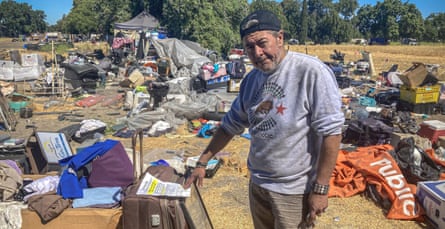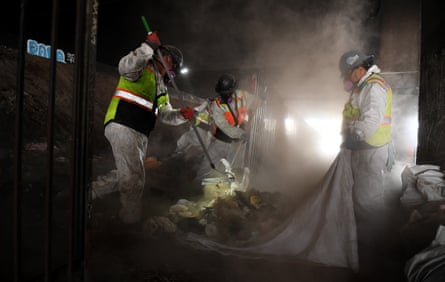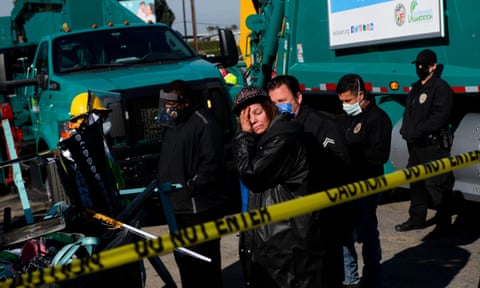This story was produced in partnership with Type Investigations with support from the Wayne Barrett Project
On an October morning, a small army arrived to evict Rudy Ortega from his home in the Crash Zone, an encampment located near the end of the airport runway in San Jose, California, Silicon Valley’s largest city. As jets roared overhead, garbage trucks and police squad cars encircled Ortega’s hand-built shelter. Heavy machinery operators stood by for the signal to bulldoze Ortega’s camp.
As the workers closed in, Ortega grew increasingly upset.
“They’re going to have to drag me out of here,” he said.
The camp, one of the largest in California, was cleared between 2021 and 2023 in part by a private company named Tucker Construction. Public spending on private sweep contractors is soaring across California.
In total, private firms have been paid at least $100m to clear homeless camps, an investigation by the Guardian and Type Investigations has found. The 14 municipalities and public agencies from which spending details could be obtained represent a small slice of such spending in the state.
Astrid Stromberg, who oversees encampment cleanups for Tucker, said its business has expanded dramatically since 2020. The company had about a dozen laborers working full-time on encampment cleanup. Now there are 30, and its clients include roughly a dozen municipalities and public agencies across Silicon Valley. “[Tucker] basically created the industry here,” she said. “I could talk about it for hours.”

Pete White, the founder of the Los Angeles Community Action Network, a homeless advocacy group based in Skid Row, says he’s observed a steady increase in the privatization of sweeps in recent years. “The growth of a private industry geared towards removing and dismantling informal settlements and houseless encampments has grown steadily in Los Angeles and across the country,” said White. “Not only are we seeing a growth in the loss of property, but also the loss of rights.”
Litigants in ongoing or recent court cases allege that the destruction of belongings in sweeps violates the fourth amendment, which protects against unreasonable search and seizure, and the 14th amendment, which guarantees due process under the law. A case currently before the US supreme court also argues that laws banning homeless people from camping or sleeping in public spaces violate the eighth amendment, which safeguards against “cruel and unusual punishment” by government actors.
Some of these cases are persuading courts. A case in San Francisco, for instance, has resulted in a city-wide injunction against sweeps while the city has a shortage of shelter beds. In a 2021 case in Los Angeles, a federal appellate court ruled that every mattress, couch and shack removed by crews must be preserved. But the issue remains a legal gray area.
Gabriella Aguirre, whose camp was removed from the Crash Zone around the same time as Ortega, rues the sweeps she has been subject to.
“You feel devastated, you feel in a rush, you feel like your whole world is coming to an end,” said Aguirre, who works at a restaurant cleaning and washing dishes. During the clearance of the Crash Zone, she alleges, Tucker crews violated city policies by disposing of items she had asked to keep, including key fobs for her car and her daughter’s car.
“It’s not so much the loss of the material things, but that they are the only things you own.”
How sweeps became a lucrative industry
The dusty fields of the Crash Zone once had houses on them, including one where Ortega’s family lived when he was born in 1976. Around this time, the neighborhood was deemed unsafe for habitation by virtue of its proximity to the runway. By the early 80s, 630 homes were bulldozed from the site through eminent domain.
Ortega moved to the Crash Zone in 2015 after losing his job as a property manager. At the time, there were just a smattering of tents across the fields. When the population of the camp exploded to about 300 people in the first year of the pandemic, the Federal Aviation Administration (FAA) said it would withhold funding for airport improvement projects if the city didn’t clear it out.
In recent years, California has approved more than $700m of funding for camp clearance, part of its strategy for grappling with a growing unsheltered homeless population of 123,000, according to a recent count.
To better understand the nature of the new industry dedicated to clearing camps like the Crash Zone, and ascertain how much spending has gone to private contractors as opposed to city crews, the Guardian and Type Investigations sent public records requests to dozens of local jurisdictions and public agencies. The requests focused on the state’s five largest cities and also on Silicon Valley.
The records show that firms vying for contracts to sweep encampments in California include mid-size construction companies that also do home renovations, as well as large environmental services firms that specialize in cleaning up hazardous waste and responding to public emergencies.
The company Ocean Blue, for instance, says on its website it cleared out more than 300 encampments in a year in southern California. “Because of our specialty in handling hazardous wastes – bio hazardous (i.e. feces, urine, vomit, needles), oils, acids, aerosols – we now perform homeless encampment cleanups for some of the largest government agencies in Southern California,” it says.

Tucker Construction was founded more than 40 years ago by a longtime San Jose resident, Mark Tucker. The company’s portfolio includes remodeling kitchens and building public works projects for the city. Stromberg said the expansion to sweeps started with a call from the city to clean out a hoarder’s house, and grew from there to include camp cleanups. Some of Tucker’s employees are formerly unhoused themselves, Stromberg said.
According to public records, the city’s contracts and purchase orders with Tucker total more than $10m in the past decade. Part of this money was drawn from federal emergency funds intended to combat Covid-19.
This is despite the fact that the city publicly stated it would not displace people during the pandemic, per Centers for Disease Control and Prevention guidelines. When asked about this use of funds, the city said some camp clearances were necessary to reduce the risk of Covid spreading among inhabitants, among other reasons.
Across California, the largest single contract unearthed was a $23m deal with the Singh Group, a major construction firm, to clear camps along state-maintained roads in the cities of Berkeley, Oakland and Emeryville.
At the other end of the scale the city of Santa Clara, a suburb of San Jose, signed a three-and-a-half-year, $1m contract with Tucker in 2019, despite having documented only 264 unsheltered residents at the time.
It can cost millions to clear a single camp. Marinship, a Bay Area construction company, received $3.4m to dismantle an unhoused community with about 200 residents.
The scores of contracts reviewed do not account for spending on the city employees and police forces that typically accompany private contractors on sweeps. The police presence at one sweep in Los Angeles cost an estimated $2m.
The pain – and destruction – of sweeps
For homeless people, these sweeps take an enormous toll. And they allege that private companies such as Tucker are breaking, or at least skirting, rules intended to ensure they are treated fairly.
Many unhoused residents report being swept over and over, often multiple times in a year. Modeling based on data collected in Boston has shown that hospitalization and death rates are expected to increase significantly among encampment residents after sweeps – researchers projected that overdoses would rise 30%, for instance.
A study of the health impacts of sweeps in Santa Clara county, where the Crash Zone is located, found that unhoused residents often lost medicines and other “health necessities” and that sweeps “drove unhoused people into hazardous, isolated, less visible spaces”. Sometimes they are even arrested and put in jail.
“Having to go through that – it’s trauma, physically and psychologically,” said Ortega. “It messes you up.”
While efforts are made to provide services and shelter to those being displaced, the vast majority start a new encampment nearby, their already tenuous stability upended in the process.
The San Jose mayor, Matt Mahan, acknowledged in an interview that this kind of sweep is a questionable use of money.
“Our goal is not to just shuffle people around the city. I think it is a terrible use of taxpayer dollars, and it is horribly disruptive for our most vulnerable neighbors.” Doing so, Mahan added, would be “the definition of insanity”. San Jose aims to get residents the shelter they need. But San Jose, like most large American cities, does not have nearly enough shelter for its unhoused residents.

As well as the loss of their homes, they allege the destruction of belongings that rules are meant to protect. At the Crash Zone, a couple named Theresa and Dave lost a bike and furniture. A man named Jose lost scrap metal he sells for income. Fujio Maeda lost the tent he was sleeping in. Rudy estimates he lost about $5,000 worth of personal property. And, he said, “I lost my trust in the city.”
Unhoused residents and their advocates say that the systems in place to prevent the loss of personal belongings during sweeps are often not effective.
In an email, Mark Tucker, president of Tucker Construction, said his company works under the supervision of city staff during cleanups. “We collect personal property, catalogue it, load it into our trucks and deliver it to a place for storage until 90 days has expired,” he wrote.
According to San Jose’s instructions to Tucker, obtained via a records request, “If there is any uncertainty regarding whether an item should be thrown away or stored, it should be stored … Unless an item is trash or poses an immediate threat to public health or safety, it should be retained for storage as potential personal property.”
But the notices to vacate posted by Tucker throughout the camp defined storable items in very different terms to the city. They specify that nothing “dirty” will be kept, which in a dusty field with no running water could conceivably be applied to most things.
According to the signs, nothing “broken or disassembled” is eligible for storage – which encompasses a high percentage of possessions in a community where scavenging is the norm. This includes “bike parts, pallets, or wood or other metal parts”. Yet for many residents who were interviewed, cobbling together parts from multiple non-functioning bikes was essential to their mobility. Pallets are upcycled into walls. Metal equals money at the recycling yard. A scrap of wood can be burned to cook dinner or keep residents warm at night.

In interviews with more than a dozen Crash Zone residents, no one said they were told that their belongings would be placed into storage. Nor did anyone successfully report retrieving belongings seized during a sweep in San Jose.
During the Crash Zone sweep, a Tucker worker who did not provide his name shook his head when asked if any belongings were being stored.
Another man sat in an unmarked pickup truck loaded with what appeared to be items from the sweep, including an acoustic guitar. He said he “sometimes” worked on the clearance crews and that he made money by selling belongings removed from the camp. Homeless residents of the camp alleged this was a regular occurrence.
Both Tucker and a city spokesperson said they had not received any reports of theft by employees or former employees at sweeps. Tucker wrote in an email that these allegations were “hearsay and not factual”.
One resident who goes by CL said he lost jacks, wrenches and other tools that he uses to work on cars, a source of income for him, after they had been thrown away by workers during sweeps. “Tools” are named by the city as items to be held in storage for residents. Following the instructions on eviction notices, the Guardian and Type called BeautifySJ, the city program that oversees sweeps, to ask where they could be retrieved.
A week later, the city replied that the tools could not be located.
The city says that it conducts sweeps within the bounds of the law and that it provides adequate oversight to ensure that contractors like Tucker abide by its policies for storing belongings. “City staff and vendors place collected personal property on tarps to identify, photograph, log and sign each item,” said Elizabeth Castro, a city spokesperson. “Once documented, items are bagged and taken to a city facility by the vendor and City staff.”
The city declined to provide a tour of its storage facility, but did offer a photo showing a small room with few shelves holding about a dozen bags of belongings.
Tristia Bauman, a housing attorney at the Law Foundation of Silicon Valley, who has studied the criminalization of homelessness across the country, says that, “from a legal standpoint, having a storage facility that is not resulting in people having a meaningful ability to get their property back is the equivalent of permanent deprivation of the property”.
Ortega sues
Ortega eventually had his day in court. Unable to find a firm willing to take his case pro bono, he represented himself. He requested a temporary restraining order to prevent his belongings from being taken during an upcoming sweep. The judge granted a series of hearings and told the city to let Ortega stay put while his case was heard.

The once-crowded fields around him emptied out as the bulldozers swept through. Many residents escaped to a much smaller adjacent field, which quickly became a densely packed encampment, until that, too, was cleared.
The judge expressed sympathy for Ortega’s situation and instructed the city to repair the secondhand camper that Ortega had obtained and tow it to a location that was not slated for active sweeping. He said the city had to ensure that any possessions that could not fit in the camper were safely stowed in a self-storage facility nearby.
Ortega saw it as a small victory, but says the legal pressure doesn’t seem to have made a difference as he observes ongoing sweeps in San Jose. “They’re still doing the same thing,” he said, “just quieter.”
Brian Barth is writing a book about the Bay Area’s unhoused communities
Quick GuideReporting information
Show
The Guardian and Type Investigations received spending records on sweeps from the following entities:
Cities: Gilroy, Morgan Hill, Sunnyvale, Cupertino, Santa Clara, San Jose, Milpitas, Fresno
Counties: Santa Clara, Los Angeles, San Diego
Agencies: Santa Clara Valley Transportation Authority, San Diego Metropolitan Transit System, Caltrans
